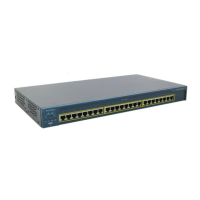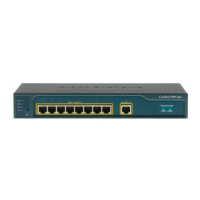16-7
Catalyst 2950 and Catalyst 2955 Switch Software Configuration Guide
78-11380-12
Chapter 16 Configuring VLANs
Configuring Normal-Range VLANs
Saving VLAN Configuration
The configurations of VLAN IDs 1 to 1005 are always saved in the VLAN database (vlan.dat file). If
VTP mode is transparent, they are also saved in the switch running configuration file, and you can enter
the copy running-config startup-config privileged EXEC command to save the configuration in the
startup configuration file. You can use the show running-config vlan privileged EXEC command to
display the switch running configuration file. To display the VLAN configuration, enter the show vlan
privileged EXEC command.
When you save VLAN and VTP information (including extended-range VLAN configuration
information) in the startup configuration file and reboot the switch, the switch configuration is
determined as follows:
• If the VTP mode is transparent in the startup configuration, and the VLAN database and the VTP
domain name from the VLAN database matches that in the startup configuration file, the VLAN
database is ignored (cleared). The VTP and VLAN configurations in the startup configuration file
are used. The VLAN database revision number remains unchanged in the VLAN database.
• If the VTP mode or domain name in the startup configuration does not match the VLAN database,
the domain name and VTP mode and configuration for the first 1005 VLAN IDs use the VLAN
database information.
• If the VTP mode is server, the domain name and VLAN configuration for the first 1005 VLAN IDs
use the VLAN database information.
• If the switch is running Cisco IOS Release 12.1(9)EA1 or later and you use an older startup
configuration file to boot up the switch, the configuration file does not contain VTP or VLAN
information, and the switch uses the VLAN database configurations.
• If the switch is running a Cisco IOS release earlier than 12.1(9)EA1 and you use a startup
configuration file from Cisco IOS Release 12.1(9)EA1 or later to boot up the switch, the image on
the switch does not recognize the VLAN and VTP configurations in the startup configuration file,
so the switch uses the VLAN database configuration.
Caution If the VLAN database configuration is used at startup and the startup configuration file contains
extended-range VLAN configuration, this information is lost when the system boots up.
Default Ethernet VLAN Configuration
Table 16-2 shows the default configuration for Ethernet VLANs.
Note The switch supports Ethernet interfaces exclusively. Because FDDI and Token Ring VLANs are not
locally supported, you only configure FDDI and Token Ring media-specific characteristics for VTP
global advertisements to other switches.

